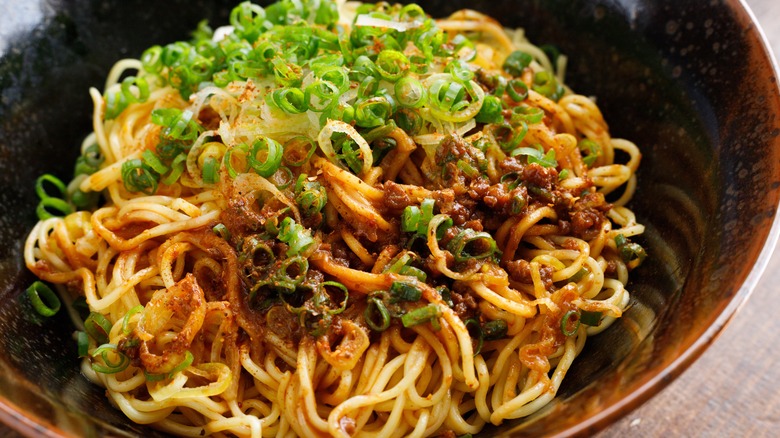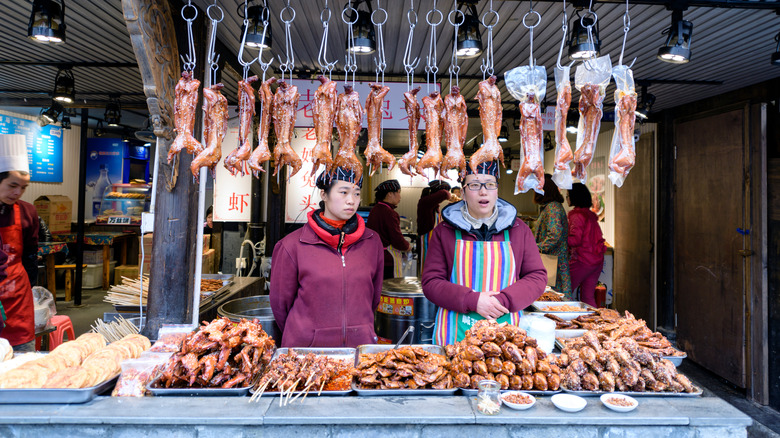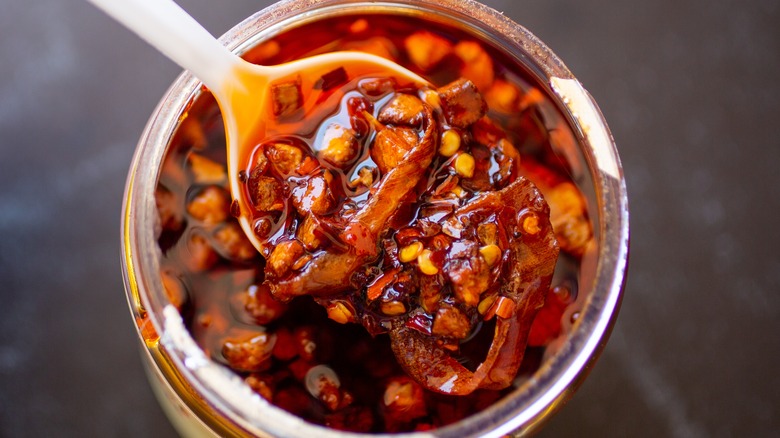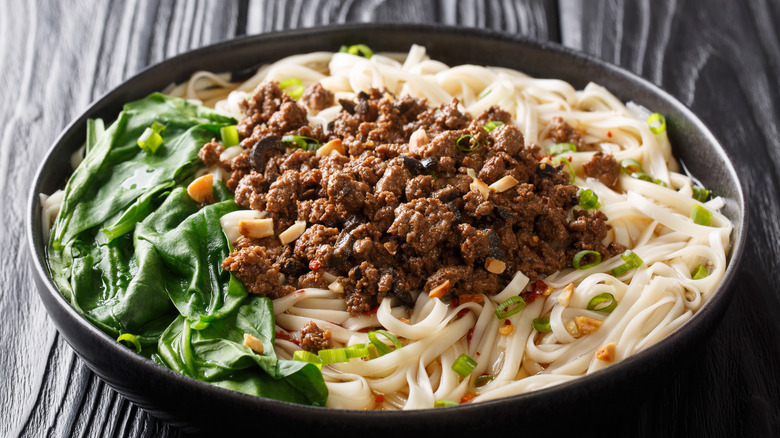Chili Oil Plays A Starring Role In Dan Dan Noodles
Spicy, rich, and sweet — no one who has tried Sichuan cuisine can say that this type of Chinese food is bland. According to China Highlights, Sichuan food is famous for featuring seasonings like Sichuan peppercorns, broad bean chili paste, cinnamon, and cloves. And it turns out there's a reason for all the potent flavors. Travel China Guide explains that the Sichuan province's locals believe that the spice in their food helps improves their skin as well as increase blood flow, which makes them less susceptible to the region's sweltering conditions.
While it's true that the spiciness in many Sichuan foods is not for the faint of heart, they're so delicious that the heat is well worth enduring. And while many might characterize Sichuan food by its spiciness, Serious Eats explains that its versatility makes the cuisine stand out. Take dan dan noodles, for example, which are a globally beloved Sichuan street food featuring noodles, pork, and sauce (via MasterClass). While chili oil is a universally agreed upon ingredient in dan dan noodles, there are many ways to customize this dish to suit your taste buds, including switching the sauces and spices (via Kitchn).
Alongside Mapo tofu and hot pot, dan dan noodles are essential to try if you're starting to dabble in Sichuan food. Let's look at where this iconic street food comes from, how it's made, and what ingredients are typically used to make it.
The origin of dan dan noodles
Dan dan noodles are known as a Sichuan street food because that's where they came from — the streets of the Sichuan province in southwestern China. According to the Michelin Guide, "dan" referred to the bamboo poles used to sell the noodles, which were fastened to baskets containing the ingredients and cooking materials. As they caught on and became a sought-after snack, people would call them bamboo pole noodles, or dan dan noodles (via Gold Thread). This was back in the 1800s when restaurants weren't a mainstream option in Sichuan, and street vendors were one of the primary ways to get so-called "takeout food" (via Splendid Spoon).
One vendor in particular, Chen Baobao, is credited with igniting the popularity of dan dan noodles. According to Chili House SF, Baobao spread the word by bringing the dish with him wherever he went in his two-compartment pot. The noodles later spread to cities like Chengdu and Chongqing, and eventually, Sichuan restaurant founder Yeung Din-Wu introduced them to Hong Kong, where he catered to local taste buds by toning down their spiciness (via Michelin Guide).
As dan dan noodles have spread beyond Sichuan, the ingredients and recipe have been adjusted slightly. Local ingredients are typically used to make this dish, notes Splendid Spoon, which can mean a thicker sauce, smokier flavor, or fresher noodles, depending on where you get them.
Ingredients in dan dan noodles
According to The Woks of Life, the essential components of a standout bowl of dan dan noodles are the noodles and greens, meat and pickled vegetables, sauce, and the starring ingredient, chili oil. The sauce is made up of chili paste, chili oil, sugar, garlic, chicken stock, Chinese sesame sauce, Chinese Five Spice, and Sichuan peppercorns, according to Recipe Tin Eats. You can purchase plenty of store-bought chili oils, but The Woks of Life recommends making your own using Sichuan peppercorns, cinnamon, star anise, oil, and red pepper flakes. Chinese sesame sauce, which can also be found in Asian grocery stores, has a potent sesame flavor that's a little stronger than tahini (via Recipe Tin Eats).
As far as the noodles, the most common variety used is wheat flour-based noodles, Red House Spice explains, and you can use store-bought or even ramen noodles if necessary, although something homemade will naturally yield the freshest results. For the toppings, ground pork and pickled vegetables, Omnivore's Cookbook shares that the pork should be a little overcooked, as you want all the liquid to have fully evaporated. You can vary which veggies get pickled, but Kitchn says for an authentic bowl, try fermented mustard greens (called mei cai) or the greens from Chinese Cardamine plants, such as Yibin yacai.
How dan dan noodles are made
While dan dan noodles can certainly be a delicious dish without it, according to MasterClass, it's of the best dishes that feature chili oil. Chili oil has become a trendy condiment recently, with varieties like Trader Joe's Crunchy Chili Onion and Sichuan Chili Crisp gaining traction on social media. You can make the sauce for dan dan noodles by dumping one of these brands in with the rest of the ingredients, however when a simple chili oil recipe only takes three ingredients (oil, whole red peppers, and red pepper flakes) and 10 minutes to whip up, why not try making it yourself?
When assembling dan dan noodles, it's essential to understand that the four main elements aren't thrown together but rather layered for a greater depth of flavor. According to Recipe Tin Eats, the order of operations is as follows: sauce (made with chili oil) in the bowl first, then the noodles, pork and pickled vegetables, and a few chopped peanuts to finish it off. Only after all the various components are in the bowl can you mix everything together and begin stuffing noodles in your mouth.



